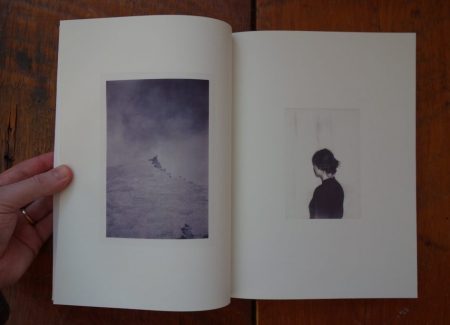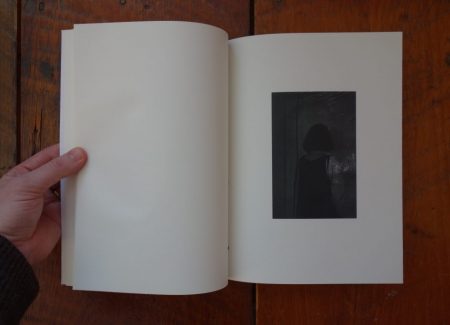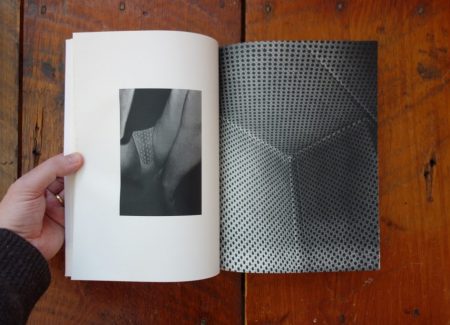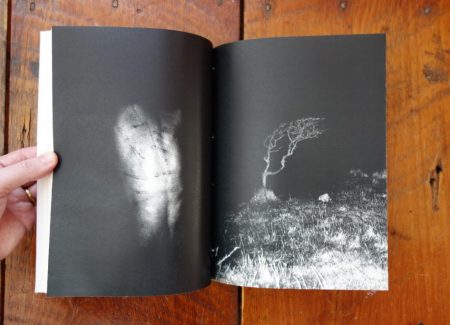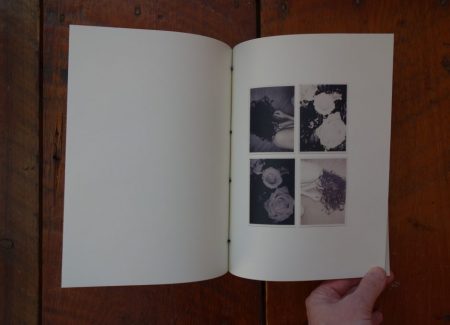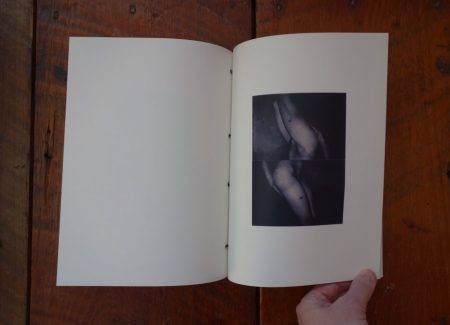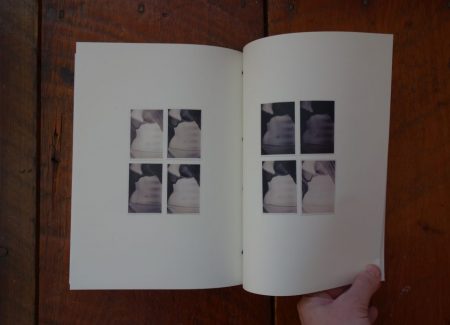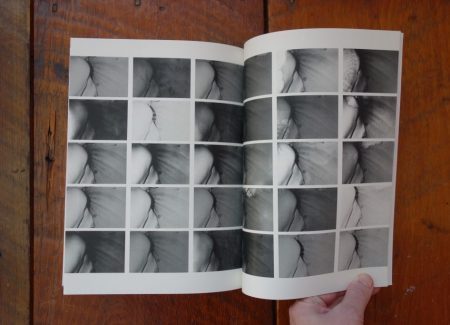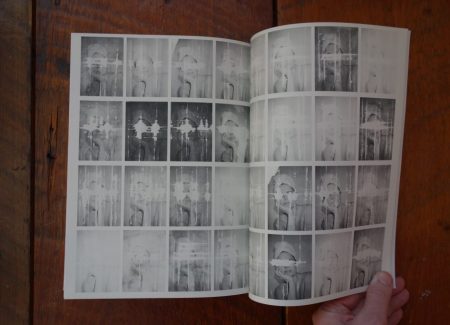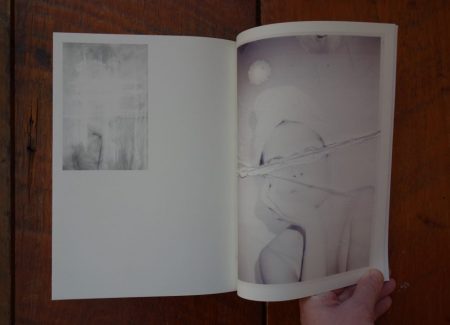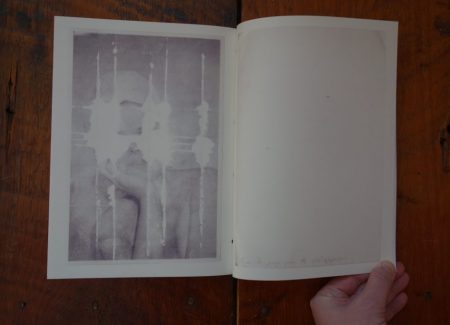JTF (just the facts): Published in 2016 by Akina Books (here). French fold stab strip binding with white cloth cover, 80 pages, with 136 black and white reproductions. In a handmade edition of 200 copies. Also available in a collector’s edition (here). (Cover and spread shots below.)
Comments/Context: Thomas Vandenberghe’s Can’t Pay You to Disappear is one of the most haunting photobooks published in the past year, and its unusual understated power comes largely through its masterful management of progression. Many photobooks follow some kind of linear narrative that visually transports us from point A to point B via a carefully considered sequence of images, but this book does so with a searing combination of poetry and anguish, building from a low controlled rumble to a crashing crescendo of destructive emotion. Mixing text, imagery, and overall design with elegant reserve, the book turns on its restrained management of anticipation and suspense, metering out each sparse crumb of information until the story’s momentum memorably overwhelms itself.
If we take Can’t Pay You to Disappear as a certain kind of scrapbook love story, seen in pictures from an unnamed man’s point of view and told in words from the third person, it begins in familiar ways, but quickly gives us subtle signs of trouble. Simple pared down nudes of a young woman open the book – the object of the photographer’s affection stands in the bathroom wrapped in a towel, wears a black garter belt, and poses long and lithe in flash lit emptiness, each image scanned and printed as if they were physical pictures glued onto the pages. But then hands roughly tied with a leather belt, and nudes with small bruises on the legs and behind feel quietly ominous, and the following spread offers the first breaking point – a jagged cliff edge falling away into smoky nothingness paired with the woman turned away, her face hidden. The next empty page gives us an elusive clue, a short text – “The day he was discharged, she was waiting for him just outside in the sunlight.”
With just those few words, it’s hard not to retroactively see any number of potential patterns in the initial images – abuse, mental illness, obsession, and other variants of passion and emotional trauma. The middle section of the photobook slowly elaborates on the reconnection between the man and woman, with stilted conversations of just a few lines and brief encounters described with a halting economy of words, giving us more clues to the nature of the fractured but seemingly intense relationship. We see images seething with implied metaphorical messages – a headless body holding a champagne glass in the engulfing darkness, an unexplained zip tie wrapped around the supports of a chair, a crumpled image of white flowers, and a muddy image of the woman turned away, the picture smudged with a large fingerprint, the physicality of the engagement with the pictures increasing and the emotional temperature getting more acute. A series of full page spreads rich with blackness then pushes us into an even darker frame of mind. Panty shots wrestle with enclosed corners, scraped bloody skin echoes the prickliness of wind gnarled trees, and a single flash lit hand seems to scrabble against a rough rock face, this fall into the shadowy recesses of memory punctuated by an endless field of thistle.
When we come out the other side of this disquieting engagement with darkness, the mood shifts once again, with the intimate images now piling up faster. Pairs of trees and slashed wallpaper give way to collaged groups of nudes and flowers, the sense of growing obsession starting to build with each page turn. The intermingled drip of text confirms some of the man’s invisible thoughts – “the rage was gone”, “there was no way out either”, and near the end “the meds were slowly wearing off”. From there, the pictures become almost bipolar, a heady mix of mania and depression. Nudes (still with bruises) are manhandled, leaving folds, rips, and finger marks, and images of bras and breasts seem to lose control and spin into countless repetitions of dark and light, the prints covered in drips and stains. The end of the book degenerates into palpable desperate anger, a portrait of the woman just out of the bath with her hair in a towel copied and recopied in page after page, each image roughly scratched until the eyes are no longer visible. The folds and scrapes continue to the point of exhaustion, where Vandenberghe then leaves us, deeply unsettled by the handcrafted toxicity of the finale.
Can’t Pay You to Disappear shares several features with other obsessive photobooks published of late, particularly Mariken Wessels’ Taking Off. Henry My Neighbor (from 2015, reviewed here), but Vandenberghe has streamlined the construction of his scarred emotional landscape in ingenious ways. The cloth tied binding, the tactile paper, the images reproduced like actual prints in an album, the loose fragments of narrative sprinkled throughout – all of these design choices lead to a book that feels intensely personal, almost like a private diary that no one was ever meant to see.
Even if we agree that the not all the photographs themselves are individually memorable here, Vandenberghe’s photobook still feels like the kind of artistic statement that forcefully sticks out from the middling pack. Its narrative progression (or degeneration) from loving attention to frantic frustration is unusually severe, and that incisiveness leaves fresh wounds behind in the mind of the reader. The all consuming desperation that fills that last few pages is equally heartbreaking and distressing, its tangible potency giving the abstract idea of interpersonal obsession some real heft and weight.
Collector’s POV: Thomas Vandenberghe is represented by Stieglitz 19 in Antwerp (here). His work has little secondary market history, so gallery retail or direct connection with the artist likely remain the best options for those collectors interested in following up.



